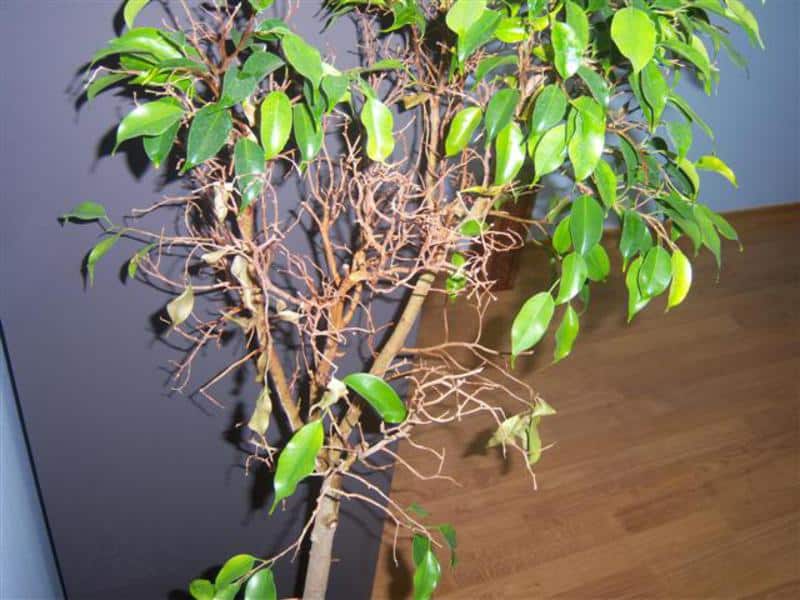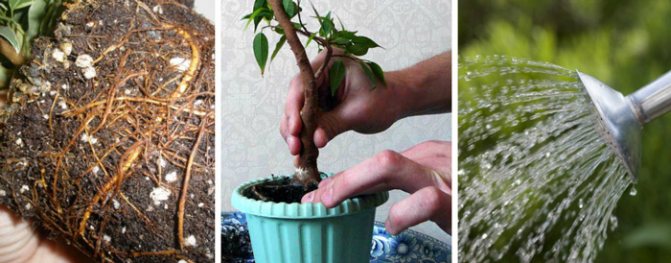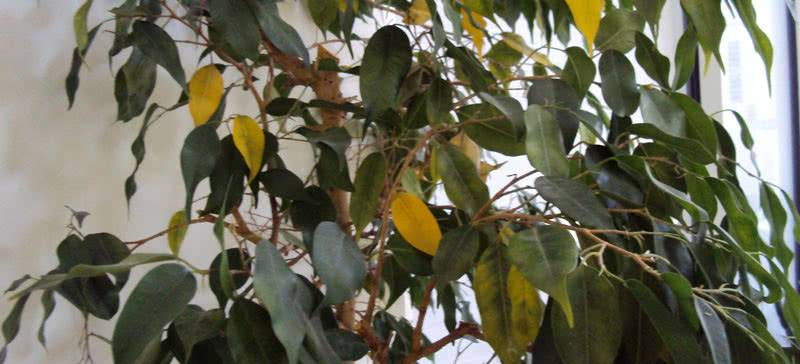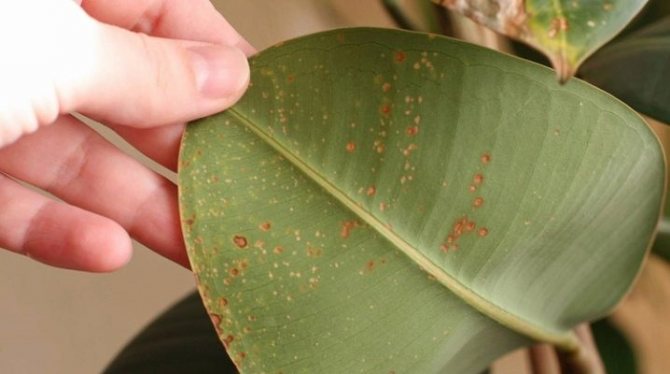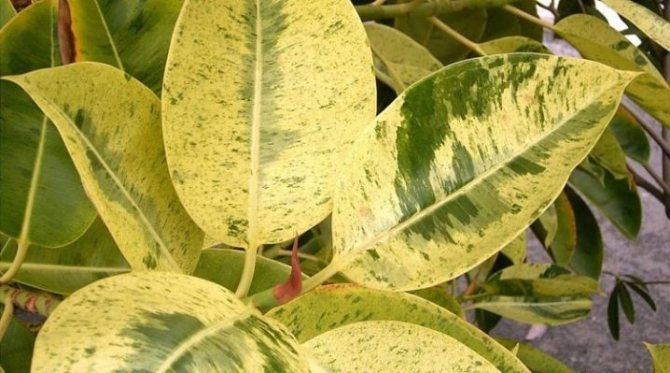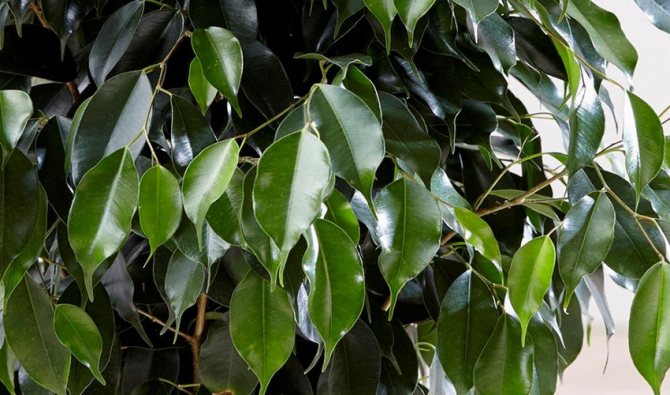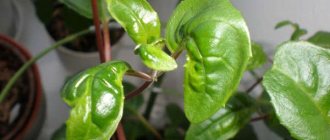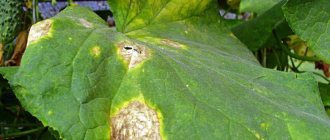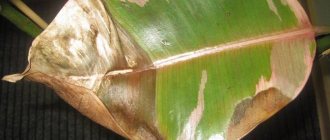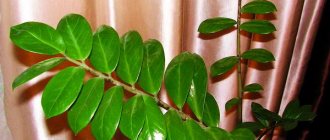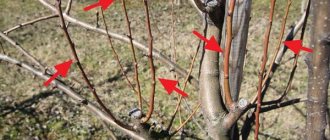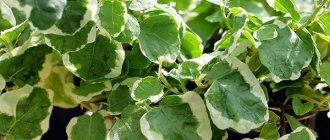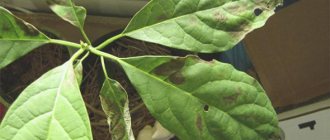Common problems
If the growing conditions are not followed, then the ficus will not look healthy. It is not necessary for the bush to be affected by insects or disease, sometimes the problem is associated with insufficient lighting. The pallor and yellowing of the leaves indicates the lack of the required amount of light. In this case, you just need to move the pot closer to the window, and in winter add artificial lighting.

The appearance of brown spots is a sign of a burn from direct sunlight.
It also happens that the fall of foliage and the appearance of blackening is the result of frostbite of the plant. You can reanimate the plant at home. The most important thing is to eliminate the source of the draft, create conditions for resuscitation. In no case should you water the flower, you need to wait for the soil to dry well. The necessary moisture is given by spraying the foliage with warm and settled water. As soon as new shoots appear, it is allowed to resume watering and use "Kornevin" - a growth activator. Orton Rost is used as a top dressing 2 times every week.
If the flower dries up or has already dried up, then you need to restore it immediately. To do this, use high-quality watering and a lot of scattered light in combination with stimulants. The root system is freed from soil and placed in water, waiting for new shoots to appear.
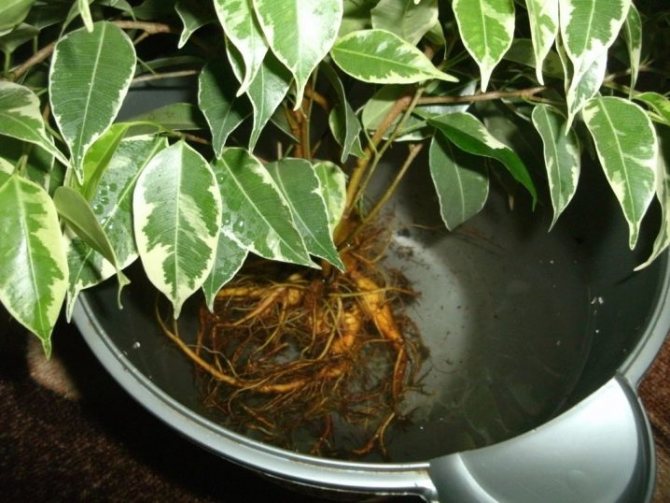

Care problems
To avoid any difficulties in the future, it is necessary to make a careful inspection at the time of purchase.
The leaves should be elastic, deep green in color without visible damage or defects, and the whole plant as a whole should have a healthy appearance.
If the foliage has spots, a small rash, or any other visible imperfections - most likely, this flower is sick and can infect other indoor plants.
At first, keep the newly purchased flower separately from other plants. This is necessary in order to identify the presence of possible problems. After a month or two, if no pests and diseases appear, it can be placed near other flowers.
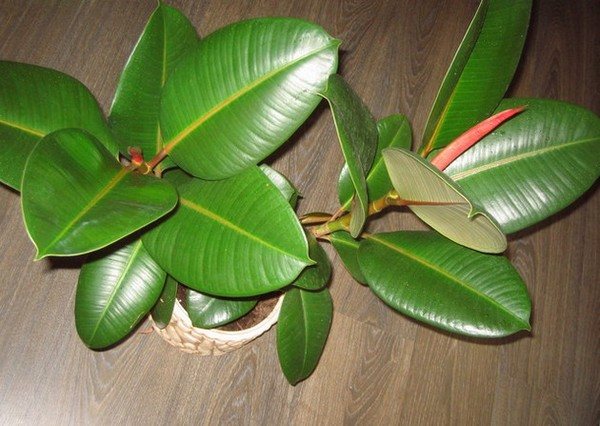

Diseases can prevail in the case of the following care errors:
- violation of the temperature balance;
- excess or deficiency of air humidity;
- untimely or frequent watering;
- lack or oversaturation of essential micronutrients.
Leaves turn yellow, what should I do?
Leaves can take on a characteristic yellow tint in several cases. The first reason is most often too dry air in the room. This problem often manifests itself in the summer with the onset of heat and during the heating season when heating appliances are used. In this case, the foliage gradually withers and crumbles.
Diseases
Ficus Benjamin diseases always develop due to unfavorable growing conditions. The main reasons for this are low temperatures (below 60 ° F) and over-watering. Effective tips for maintaining a healthy plant are to use a pathogen-free planting soil and container, and a disease-free seedling. It is worth taking a closer look at common problems with ficus and how to solve them.
- Leaf fall... This is the most common problem for novice growers and is usually caused by temperature changes.Ficus loves constant conditions, therefore it is necessary to maintain the same level of heat and humidity. A change in these two factors, even within the range of 5-10 degrees, will lead to leaf fall. The only way to fix the problem is to stabilize the environment and continue to water and fertilize the flower regularly.
- Brown spots. Cercospora looks like tiny black dots on the leaves. In this case, they can turn yellow and fall off. The grower will need to remove diseased shoots and spray the plant with a specialized agent, and subsequently prevent high humidity. The use of sulfur helps, it is sold in sprays. Copper fungicides can be used at the first sign of illness to prevent its spread. Organic products will prevent spore germination.
- Anthracnose... This disease manifests itself as rusty spots on the stems and leaves. When a problem arises, diseased leaves are removed, and in the future they practice good sanitation. Collecting and disposing of all affected plant parts and providing adequate light, water and fertilizer will strengthen the plant's ability to resist fungus. Chemical treatments are rarely used because indoors they can be harmful to occupants.
- Juice oozes from the ficus. This condition is caused by the appearance of sucking pests. Mealy bugs look like small cotton bunches, and the scales look like white or black spots on the stems and body of the tree. The problem is eliminated by using horticultural oils or soap solution - 1 tablespoon of soap per 4.5 liters of water.
- The appearance of inflamed areas. Such swollen areas can form on leaves (in large veins), stems, and sometimes roots, near stem cuttings. It is caused by a bacterium. It can be destroyed by removing the affected plant parts to prevent spread. Using herbal sprays containing copper is an effective treatment for this condition.
- Black spots. Very small marks usually develop on the underside of the leaves. This is nothing more than a fungus; with a very strong infection, the foliage turns yellow and falls off over time. You can prevent further spread of the disease by removing the infected areas and spraying with a fungicide. Spotting can also be caused by an aphthous lesion. The stains may appear rusty and may ooze at times.
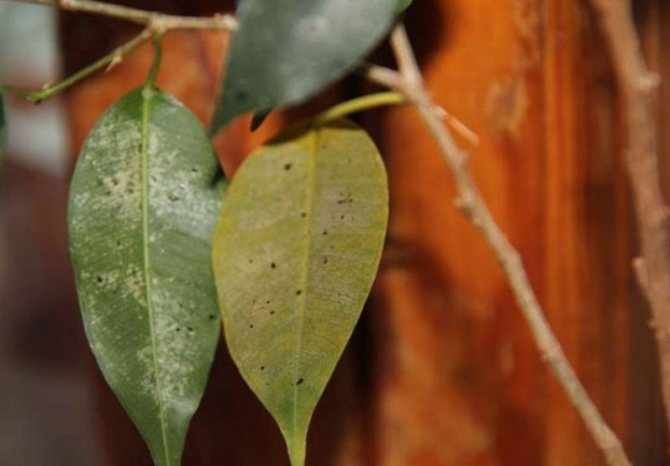

Frequent problems
Ficuses have their own specific problems that are most common for them. Let's talk about why they arise and how to solve them.
Why do ficus leaves fall


On a healthy plant, the leaves live for 2-3 years, after which they begin to fall off. The fact that ficus sheds old leaves is a natural process that should not cause concern. Crohn in this case is quickly restored due to the growth of new leaves.
But sometimes the leaves fall off too much. The reason for the unexpected leaf fall may be the rearrangement of the ficus to another place. He does not like ficus and drafts, take this into account when placing it.
On a note! Ficus should be put in a permanent place from the very beginning and disturbed as little as possible. If it becomes necessary to move it to another room, the pot is placed with the same side to the light as it was before.
Why do the leaves turn yellow, what to do
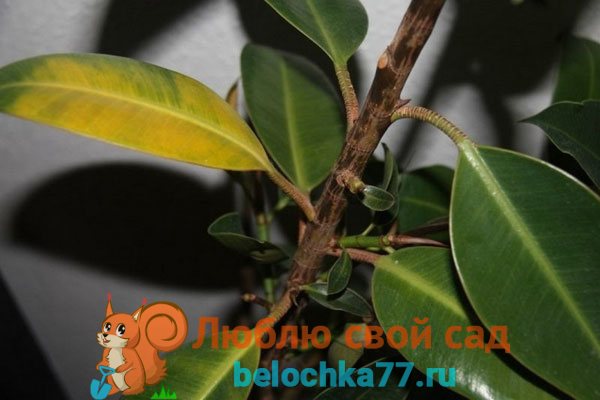

Natural aging of the leaves begins with yellowing. First, the leaves in the lower part of the crown are updated, because they are older. If the top of the head turns yellow on the ficus, you need to look for other reasons.
These plants love moderate watering with a little drying of the earthy coma. If you regularly pour ficus and do not maintain the required intervals, it will respond with yellowing of the leaves.If you notice such an unpleasant phenomenon, pay attention to whether there is water in the pan and drain it in this case. When overflowing, the ground must be thoroughly dried; the flower cannot be watered for 2 weeks. Instead of watering, you can sometimes wipe or spray the leaves.
By yellowing the crown, the ficus can also respond to a lack of lighting, keeping at low temperatures. Yet this is a tropical plant that needs a lot of light and a comfortable temperature regime.
In winter, it is advisable to provide ficus with illumination and a temperature of at least 18 ° C.
Ampel varieties are especially sensitive to dry air. At low humidity parameters, they can curl the leaves, which will turn yellow at the same time. Spray the shoots with warm water more often, especially during the period when the heating is on.
Leaves can also turn yellow from insufficient nutrition, especially fast-growing species. During the period of active growth, ficus must be fed once every 2 weeks with complex mineral fertilizer. In winter, top dressing is applied once a month.
The yellowing of the ficus foliage can be caused by the presence of pests. To make sure of this, carefully examine the plant, especially on the underside of the leaves. Small dark spots and dots, sticky bloom on the leaves should alert you. The sooner you treat pests if they are found, the faster the plant will regain its healthy appearance.
Cattleya Orchid - home care
Spots on the leaves
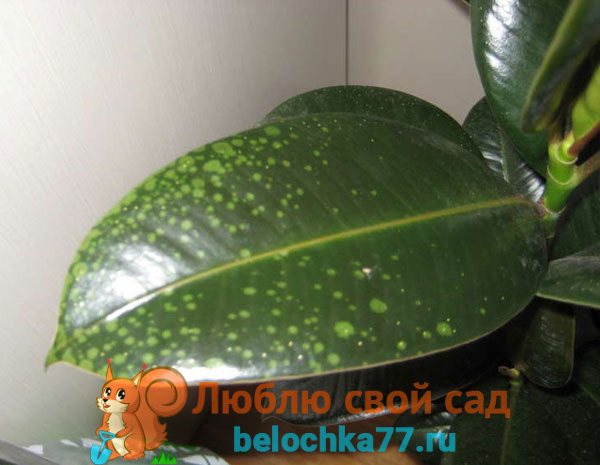

Problems with the plant may appear even before the purchase. Therefore, carefully examine the ficus that you have chosen in the store. If the leaves are already stained, it is best to set the pot aside. After all, the plant will have to undergo acclimatization in a new place, and only healthy plants can do this.
Attention! If spots on the leaves of a flower have appeared already during the period of stay in your home, look for the reasons for their appearance in improper care and the appearance of pests.
We wrote above that spots and dots appear with various fungal diseases, damage to the flower by pests, due to rotting of the roots as a result of excessive watering - in this case the leaves become gray, lose turgor.
Ficus treatment and simple care: video
Anyone who truly loves flowers will definitely monitor their condition and create the necessary conditions. There is an opinion that flowers feel our love and care and respond to this. It's hard to argue with that. After all, these are living beings and some people argue that plants even understand speech addressed to them. A loving and responsible grower will always have a home like a lush garden.
Harmful insects
Some plants are better suited to pest control, while others need extra help. Before buying ficus, it is important to study what problems are typical for these beautiful trees.
- Mealybug. They are small, white, fluffy sucking insects that congregate in large clusters. They can appear after watering, as they crawl to the surface of the soil. They can be seen in areas of the plant where the branches meet the main stem. There are several ways to treat insects. You can spray the foliage with garden oil or treat the soil with chemicals. If you do not want to use chemicals, then spray a soapy solution. The liquid is prepared with the calculation of 1 tablespoon of soap per 4.5 liters of water.
- Centipedes. They are brown insects with a long body and many legs. If they do appear, chances are the soil was not sterilized before the tree was planted. The best way to deal with this problem is to change the soil, sterilize a new one. The pot must also be cleaned out - this is the only way to make sure the grower is free of pests.
- Shield. Like other insects, the scale insect does not tolerate high humidity and soapy treatment. It is not difficult to save a plant from it, you just need to spend a little time on processing.
- Thrips. It is an insect that is difficult to get rid of and even harder to see as it is very small. You can inspect the foliage for the appearance of small dark spots, that is, the waste that they leave on the ficus. To get rid of them, you first need to water the plant from the shower, then spray it with neem oil.
- Whiteflies... They often attack the flower. They immediately become visible by a white bloom. To prevent them, neem oil sprays should be used. The standard yellow sticky traps are also good remedies.
- Spider mites. You can get rid of them with a simple soapy solution or a strong shower.
- Aphid... When twigs and leaves curl up, it can be a sign that aphids have appeared, which, in turn, is also a carrier of bacterial diseases. They get rid of it with an alcohol solution, which needs to be wiped off the trunk and leaves.
Read also To what size does a trout grow?


Pests attacking the plant
Spider mites on ficus, thrips on ficus, mealybugs - all these parasites can cause a lot of harm to your green specimen. For example, the invasion of a spider mite is noticeable far from immediately. It is quite difficult to find parasites on a flower when there are only a few of them.
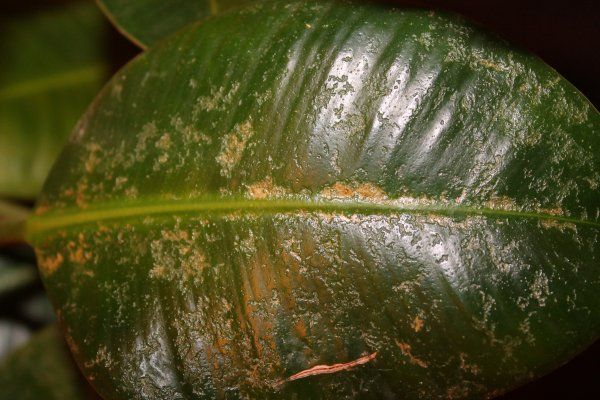

But with a huge colony of ticks and more difficult to fight. That's why it doesn't hurt to regularly check the flower for mealybugs or aphids on stems and leaves. If aphids appear on a ficus, how to deal with it? Buy effective insecticides and treat the flower thoroughly.
Fungal and other diseases
If the leaves start to fall in the fall, there is no reason to worry. This is completely normal. However, there is also other reasons that negatively affect the growth of the ficus.
- Root rot It is caused in two ways: poorly drained soil or too frequent watering. Any of these situations will cause the roots to soften and rot. It is very easy to prevent the appearance of the problem, it is enough to establish irrigation control and organize high-quality drainage.
- Phomopsis ulcer caused by cutting with a non-sterile instrument. This fungal disease enters the plant through slices. The easiest way to fight is to completely cut off the affected branch, since there are no chemicals on the market for treating this disease.
- Ficus sometimes attracts fungal pathogens that cause crown rot or stem rot... It attacks the plant from the ground line, causing the crown to rot and the leaves to turn yellow, wither and even die. High humidity contributes to the appearance of white bloom on the soil and stems. Brown spots appear, sometimes gray mold. Spraying healthy foliage with a mancozeb-based fungicide will help.


Most bacterial diseases cannot be cured, so the plant is completely destroyed. Good care can prevent infection. A simple complex of fertilizers, applied on time and in the required amount, helps revitalize the plant if it does not grow well.
For information on how to deal with Benjamin's ficus pests, see the next video.
Growing indoor flowers is no easy task. Each plant needs to find its own approach. And, accordingly, any indoor flower requires special care. Ficus Benjamin belongs to common indoor evergreen flowers. This plant does not require special care, but it needs protection from diseases and various pests.
In the article we will consider which diseases of the Benjamin ficus are the most dangerous for the flower. We will also talk about what pests can attack an evergreen flower.I will also talk about the measures of their treatment and prevention.
Infectious diseases
If various pests appear on the leaves of Benjamin's ficus, you can fight them quite effectively, especially if the problem was noticed by you at an early stage. But if you are faced with infectious diseases, it is much more difficult to cure a plant from them.
The first signs are difficult to notice, and when a flower is seriously ill, even the most effective methods do not always give the desired result. To defeat infectious diseases of ficuses, it is necessary to consider in more detail what ailments of the plant a domestic florist may encounter, and what to do in this case.


Ficus Benjamin diseases
It is possible to determine that Benjamin's ficus is sick by its external changes. If earlier the plant had lush, lush green foliage, and then the leaf fall suddenly began, then this indicates the development of a certain pathology. Indicates the development of the disease and growth retardation, as well as other characteristic signs.
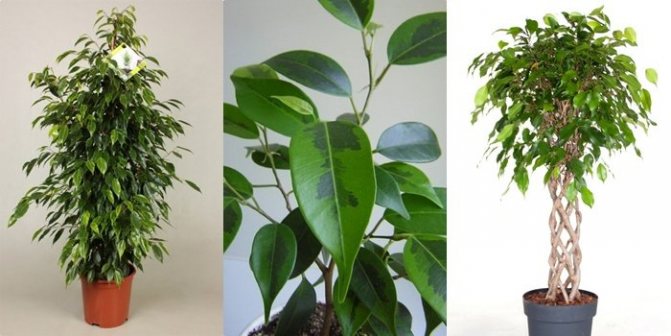

When early signs of the disease appear, it is necessary to immediately begin treatment of the indoor flower. The neglect of the pathological process can end in death for the ficus.
Root rot
A dangerous fungal disease develops on the roots of the plant. The onset of the pathological process can be determined by the characteristic bloom on the soil surface - it is presented in the form of a dense crust. Secondary signs of root rot are lethargy and leaf fall, slow flower growth.
If signs of disease are found, the plant should be removed from the pot and its roots should be carefully examined. If they are dark and soft to the touch, then the flower cannot be saved, it must be destroyed. If the roots are light, and only a small part of them is damaged, then emergency treatment should be started:
- cut off diseased roots, treat the cuts with activated carbon powder;
- transplant the flower into fresh soil;
- treat the diseased plant with the fungicide Carbendazim.
Root rot is often provoked by waterlogging of the soil, therefore, in order to resist the disease in the future, the plant must be provided with moderate watering.
Foliage
The appearance of spots on the surface of the leaf plates can be caused by various factors - sunburn, spraying the leaves with cold water, etc. As for diseases, the formation of dark spots is often associated with the multiplication of a pathogenic fungus.
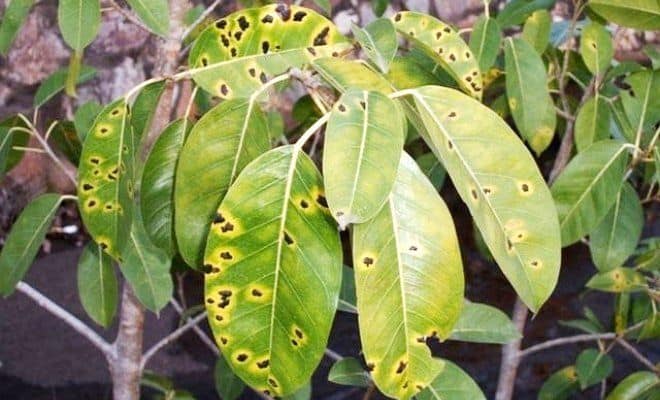

- Anthracnose. The spots are dark brown in color. They are spread over the leaf plate. Subsequently, spots form into ulcers. If you do not start treatment in a timely manner, the flower will die.
- Cercosporosis. Small dark spots form on the underside of the leaves, their surface is covered with numerous black dots. Affected foliage turns yellow, falls off. Late treatment also leads to the death of the flower.
As soon as the first pathological symptoms began to appear on the ficus, it should be moved to a well-ventilated room, and then watering should be limited. In the future, antifungal therapy is carried out with the use of appropriate drugs.
Symptoms of leaf disease
Most often, health problems of the ficus arise due to a violation of the conditions of its containment. Before starting to treat the plant, you should carefully familiarize yourself with the available signs, on the basis of which you can establish the cause of the ailment and take measures that best suit the specifics of the situation.
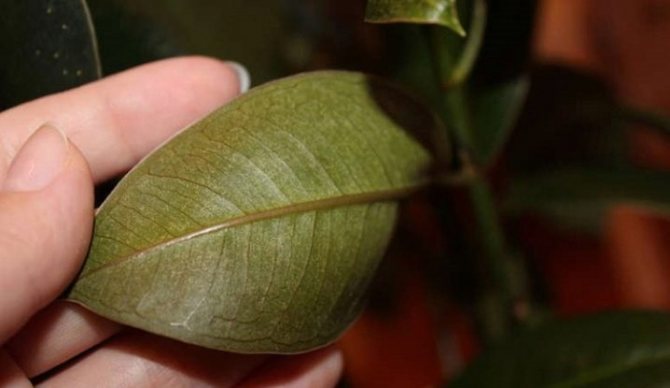

Turn yellow and fall
Ficus lovers encounter this problem most often. It is important to consider that the described plant regularly sheds yellowed lower leaves (the oldest), this is not a deviation from the norm.You should be worried in situations where these symptoms affect all the plates of the rubbery ficus - even those located on the upper shoots. If we single out the reasons for the misfortune under consideration, then their list will look like this.
- Too frequent and / or abundant watering, leading to decay of the plant root system. A characteristic feature is an unpleasant odor emanating from the ground.
- Moisture deficiency. If this problem occurs, the leaves of the ficus can change from dark green to yellow and fall off over time.
- Excess minerals. Situations where the soil has accumulated an excessive amount of salt can lead to the loss of all foliage and the death of the plant.
- Insufficient lighting. Despite the high shade tolerance of the rubber-bearing ficus, its location in the twilight significantly weakens its health.
- Deficiency of nutritional components. It manifests itself in situations when the plant is in the same soil for a long time and is not fertilized properly.
The loss of healthy leaves by the rubber-bearing ficus deserves special mention.
The most common cause of this problem is hypothermia of the plant root system, which is especially dangerous in combination with strong drafts.
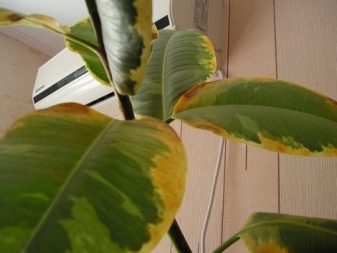

Curl up
Considering that the leaves of the rubber-bearing ficus take part in the respiration of the plant and the processes of evaporation of water, it should not be surprising that they twist due to its deficiency. This is a natural reaction of the plant in situations where the temperature is too high and the humidity level is unacceptably low. In a similar way, ficus reduces the intensity of evaporation, which threatens it with dehydration, which is important for rooms with dry air (especially if they are equipped with air conditioners and heating devices).
Another reason that can lead to the problem under consideration is insufficient and / or irregular watering. To determine the degree of soil moisture, you need to stick a wooden stick into it to the depth of the roots, and then carefully pull it out. Bits of soil adhering to it will indicate that there is no problem with moisture in the substrate, while a dry surface of the tool used will indicate that the plant needs more water.
If there are small white dots on the curling leaves of the ficus, it can be stated the presence of a spider mite - a dangerous parasite that feeds on plant juices and leads to its exhaustion. This pest prefers to be located on the inner surface of the plate, but traces of its activity are also noticeable on the outer side, which is gradually discolored.


Dry and stop growing
If the young leaves of the ficus began to shrink, you should pay attention to the nutrition of the plant: most likely, it is insufficient. This recommendation is also relevant in situations where the development of the rubber plant has completely stopped. As for the thinning and gradual drying of the sheet plates, then these problems are most often caused by the action of heating devices and direct sunlight.
Ficus Benjamin pests
Like numerous diseases, the spread of pests on Benjamin's ficus is a consequence of improper care. Among the huge variety of pests, most often on a houseplant you can find aphids, scale insects, mealybugs, spider mites.
Shield
The appearance of the pest is small in size, convex dark or black growths that spread on the surface of the leaves of the plant. If the scale is "young", then its body is soft to the touch, in adults it is hard.
The scale insect feeds on the delicate sap of a flower. It can parasitize not only on foliage, but also on other structural parts of the ficus. The danger of the pest is that the product of its vital activity is a sticky mass, which serves as a favorable environment for the development and reproduction of a sooty fungus.
- black or brown growths are visually visible on the plant;
- if the build-up is torn from the sheet, then a through hole is formed on it;
- the affected leaves turn pale, wither, and then fall off.
Read also How to plant frigo strawberries
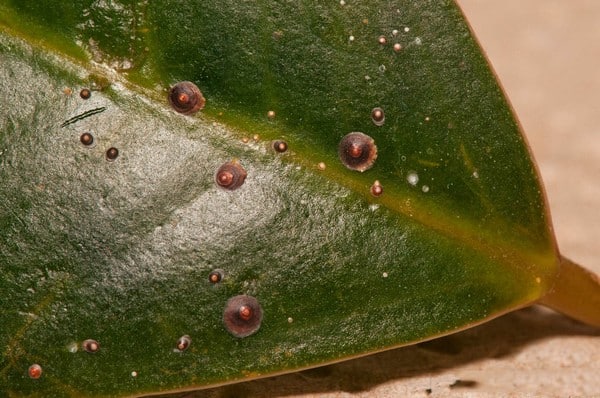

- to cut and destroy heavily-affected flower structures;
- to get rid of sticky plaque, wash the plant thoroughly with soapy water (take 30 g of soap shavings for 1 liter of water);
- treat the ficus with Actellik.
Spider mite
It is impossible to see the parasite without special devices (microscope), since it is very small. But signs of spider mite parasitism are clearly observed on the affected plant.
- on the surface of the foliage, a white bloom forms in the form of a cobweb, specks or thin stripes;
- the affected plant structures turn yellow, wither, the leaves begin to fall off;
- the flower lags behind in development, with a strong defeat - it dies.
- move the plant to a well-ventilated area (the spider mite does not tolerate fresh air);
- treat the diseased ficus with soapy water;
- preparations against spider mites - Fitoverm, Actellik, Sunmite.
Thrips
The smallest parasites invade the plant and lay eggs, from which a new generation of pests is subsequently born. The distribution of thrips can be determined by convex small stripes (laid eggs) on the underside of the leaves.
The affected flower begins to wither, the foliage turns yellow, dries, falls off. Significant damage leads to the death of the ficus.
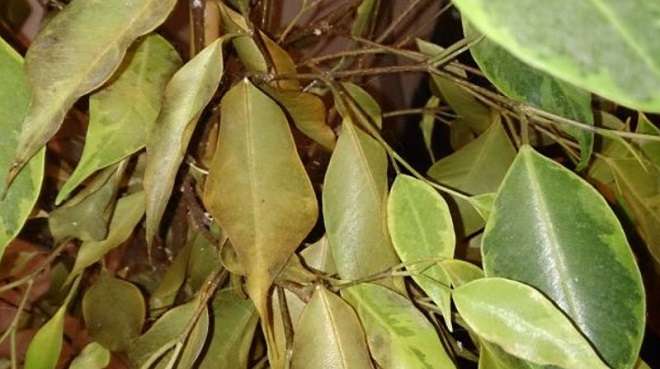

- urgently move the diseased plant away from healthy flowers;
- in the fight against thrips, only chemicals are used - Mospilan, Aktara.
Small insects of green, transparent or yellowish color settle on the underside of foliage or at the base of the stem. Aphids prefer to live in colonies, so it is not difficult to determine its appearance.
Aphids are very dangerous for indoor plants. The pest is gluttonous and fertile. If you do not start a fight against him in a timely manner, then the flower will die in the shortest possible time.
To destroy aphids, insecticides are used, for example, Aktara.
Mealybug
The pest is a small, oblong-bodied insect covered with a fluffy bloom resembling cotton wool. Mealybug is able to infect any part of the plant, leaves, trunks, basal stem.
On the affected plant, the leaves dry, turn yellow and fall off. Timely destruction of the parasite will help save the flower from premature death.
- rearrange the diseased flower away from healthy plants;
- brush away pests with a soft brush;
- treat the ficus with soapy water, paying special attention to the affected structures;
- drug against mealybug - Actellik (the treatment is repeated at least 2 times with an interval of 3 days).


Ficus diseases
develop due to improper care, various infectious diseases and due to infection with fungal spores. No less harm is caused by pests of ficus, feeding on plant sap and gnawing passages in the veins of the leaf and stem. Some insect larvae poison the root system with their poisons. The flower begins to wither. The foliage changes color and becomes stained, dies off and stops growing. Later, the roots rot and the plant dies.
Ficus does not tolerate leaf diseases, but it can recover, like any plant, if the cause of their modifications is noticed and eliminated in time. It is also characterized by very specific features of the change in appearance, not associated with the activity of pathogenic micro- and macroorganisms. Common diseases and problems of ficus are described below.
Sooty mushroom and fight against it
Sooty fungus, also called black, is a fungal disease that mainly affects young and weakened plants, as well as plants kept in conditions of high humidity and in poorly ventilated or not ventilated rooms.Palms, boxwood, laurel, ficuses, orchids, etc. are most susceptible to black fungus. And since fungal diseases are considered the most dangerous and difficult to treat, they must be dealt with.
General information about the disease
The cause of the sooty fungus is not only the lack of fresh air. The sooty fungus is distinguished from other types of fungus by the fact that the sticky, sweetish secretions of insect pests (mealybug, whiteflies, aphids) are an excellent breeding ground for it. It is this factor that acts as the root cause of the development of the disease. The ill-fated fungus disrupts the processes of photosynthesis of plants, clogging their pores. The growth of a colony of a sooty fungus leads to the fact that individual leaves begin to die off, and if the situation is started, the plants themselves die. At the very beginning of the disease, a black or gray bloom resembling soot is formed on the leaves of plants, as well as on their fruits and stems. It differs from the plaque formed during anthracnose in that it can be easily removed with a sponge. First, the plaque is located on the plants in separate small specks, which subsequently grow and combine with each other.
It should also be noted that the undersides of the leaves of a number of indoor plants, and even more so orchids, become sticky even in the absence of any pests. The resulting substance also has a sweet taste and is a fertile ground for the subsequent development of the fungus. In this regard, the leaves should be regularly wiped thoroughly with a sponge on both sides.
How to fight
The most important thing is to provide the plants with a humidity level of about 50%, as well as access to fresh air. This preventive measure will significantly reduce the risk of a sooty fungus appearing on them. Other preventive measures worth mentioning are: ample vegetation; burning weeds and old leaves; control of humidity and temperature, as well as regular ventilation in greenhouses or premises; treatment of trunks before the start of the growing season with copper sulfate with lime. By reducing the total number of insect pests by these methods, it is possible to minimize the possibility of infecting plants with such an unpleasant ailment. Plant immunity should be maintained by creating optimal conditions for them, as well as by regular feeding with micro and macro elements. Thickened tree crowns should be thinned regularly, and excessive soil moisture should be avoided. If, nevertheless, signs of damage by harmful insects began to be detected, the plants should be treated with insecticides (Bankol, Aktellik, Aktara and others). Among the sparing drugs, Fitoverm is worth noting - it contains microflora that suppresses the development and growth of fungi. The plaque formed by the soot fungus on plant tissues is removed with a wet sponge or with the help of a shower. Sometimes, to remove the sticky dew of insects, the leaves are washed with a solution of alcohol or fresh beer, which as a result gives the plants an additional shine. Severely affected leaves are usually removed. Treatment with fungicides of vegetation is usually not required, since with the disappearance of insect pests and after removal of plaque, the disease usually disappears. However, if such processing is still needed, then it is better to take fungicides of the copper group - Ditan M-45, Strobi, Horus, Flint, Skor, etc. And the population density of sucking pests emitting sticky excrement is controlled by neonicotinoid (Confidor, Mospilan, Aktara) or pyrethroid (Fury, Sherpa, Fastak, Decis) insecticides. Also, plants can be washed with a copper-soap solution (for 10 liters of water - 150 g of soap and 5 g of copper sulfate). And trees are treated with solutions of copper oxychloride or Bordeaux liquid.
Why does the leaf get stained
Spots on the leaves of ficus arise due to the unscrupulous care of the grower for the plant, as well as due to the activity of the fungus and the parasites that attacked it.
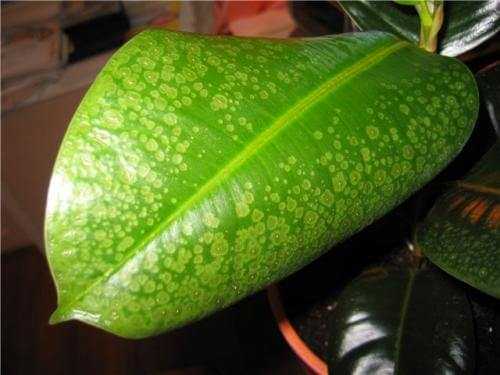

In the photo there are spots on the leaves of the ficus
Let's figure out the reasons for the appearance of an uncharacteristic pattern and color of foliage, which are most common:
| Color | The root of the problem |
| Brown leaf color | It is characteristic of some types of ficuses. The plant could tolerate stress after transplanting. |
| Brown spots | Increased temperature and dryness of the air. Overfeeding with mineral fertilizers. |
| Reddish brown spots | Sunburn. Exposure to a draft. Excessive watering. Damage by fungus or parasites. |
| Brown plaques along leaf veins | Infection with a scabbard. |
| Brown spots resembling strokes | Defeat by thrips. |
| Small yellow dots, yellowish leaf edges | Overflowing. |
| Red dots, whitish bloom | Leaf damage by thrips larvae. |
| White or grayish spots, cobwebs | Spider mite infection. |
Ficus burns foliage photo
Other stains
Botrytis forms large rusty spots with concentric rings. Tiny, slightly raised, dark green or red formations on the underside of the leaves are the main symptoms of this disease. Corynespora spots may appear on young shoots as large reddish dots. There are several other fungal diseases that affect ficuses just as often. Fungal ulcers are crusted lesions that can encircle and kill the shoots.
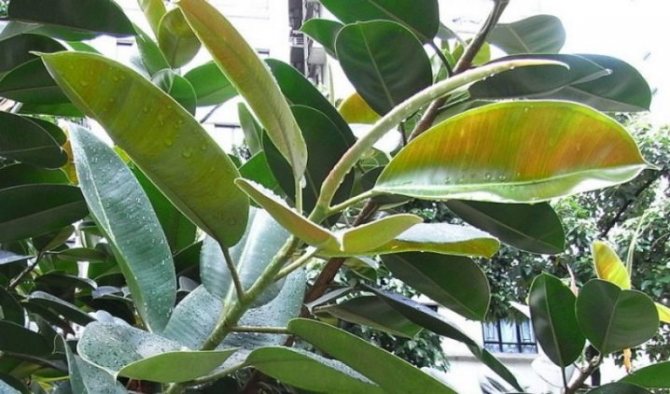

The fungus Sclerotium rolfsii causes rot, white cotton mycelium with such an infection grows not only on the stems, but also on the leaves of plants and causes their death. There are no chemical agents to prevent or treat this problem. If the ficus is covered with such spots, it must be destroyed. All bacterial diseases are fatal. Agrobacterium tumefaciens causes slightly swollen patches on infected leaf veins, stems, or roots. Xanthomonas starts out as tiny water-soaked spots on foliage. They grow rapidly and may have bright yellow edges. In this case, it is possible to use bactericides.


For the proper care of ficus, see below.
Brown spots on the leaves of the ficus are a signal indicating that either one of the infections has hit the flower, or pests have attacked it. Most often, flower growers have to deal with non-infectious diseases, which were caused by the actions of the owner of the plant.
Why does foliage turn yellow and fall
Many tree species of ficuses shed their foliage for natural reasons, for example, during the autumn-winter season. If the leaves began to fall off at an accelerated rate, then the problem was to look for in insufficient watering. The health of the ficus is also badly affected by a change in the place of its growth. In addition to the above, the deterioration of the condition of the plant, yellowing and dropping of its foliage can be affected by:
- Excessive watering.
- Lack of light.
- Heat and dry air.
- Low temperature and hypothermia of the plant.
- Excessive sun exposure.
- Overdrying of soil.
- Underfilling.
- Lack of minerals in the soil or an excess of them when overfeeding.
- Pest, fungus or infection.
- Unsuitable pot.
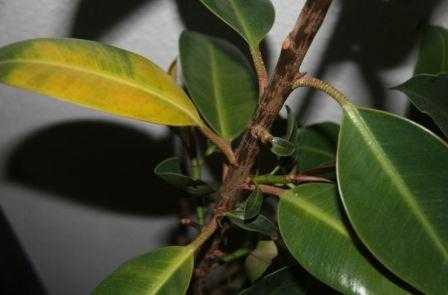

ficus yellowing leaves photo
Fungal diseases
Gray rot
You can detect such a disease simply by examining it. A characteristic feature is mold all over the plant... It is able to powder not only leaves, but also a branch with a trunk, acts like ordinary dust, and is easily shaken off at the slightest contact.
The infected areas turn dark and die off over time. A favorable environment for the development of gray rot is dampness in warmth.
Sooty mushroom


Plaque gray or black, formed only on foliage.
Appears in the presence of aphids, scale insects and similar pests, when they secrete sticky mucus.
In this case, you need to eliminate the infected area or treat it with a solution of soapy water with a sponge.
Then spray the whole flower with a solution of the funicide, right down to the roots.
Powdery mildew
It has all the same features as a sooty mushroom, only differs in white bloom on foliage, which is easily washed off in the initial stages of the disease with a solution of laundry soap. If the stage is more serious, the affected areas are removed.
Cercosporosis
Dark spots that spread down the back of the leaves. The disease originates and develops in the Cercospora fungus in waterlogged air. The spots gradually grow throughout the plant, after which the leaves dry up and fall off, in some cases the ficus may not be saved.
You can solve this problem spraying with antifungal drugsafter removing diseased leaves.


Anthracnose
Anthracnose infection has almost the same symptoms as cercospora. Only in addition, wounds are still formed on the edges of the leaves.
You can also get rid of this ailment with antifungal drugs.
Root rot
The ordinary process of suppuration of the root system is caused by an excess of soil moisture. In this case, the chances of life for the ficus are small.
To prevent this disease, use watering with a weak solution of potassium permanganate no more than once a month.


Infections and fungal infections
Proper care will keep any plant healthy. But sometimes even he is not able to get rid of unwanted problems that arise against the background of the diligent care of the grower. Ficus diseases arise through the fault of external factors: initially latent diseases in newly purchased plants, cuttings, when replacing the soil mixture or transplanting into open ground.
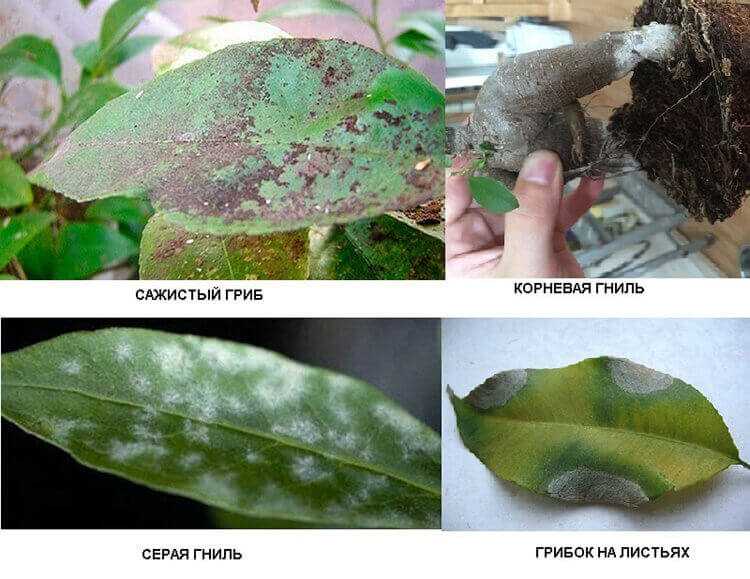

Ficus infections and fungal infections
Attention! Even prepared soil bought in a store does not always guarantee that bona fide manufacturers have disinfected it from the larvae of ficus pests.
The most common diseases of any species of the genus of ficus include:
Powdery mildew
White patches that look like a fluffy coating that are easy to wear off.
Reason: from direct sunlight, insect damage, subsequently infected with fungus. Treatment: The plaque is washed off with a sponge soaked in soapy water. Severely affected leaves are removed. The plant is treated with a fungicide.
Anthracnose or rust
Uneven, rusty spots with a brown border along the edge of the leaf. After some time, holes form in their place. Later, the leaves completely darken and die off. Cause: Colletotrichum orbiculare fungus. Treatment: The diseased areas are cut off, the ficus is treated with a fungicide and copper oxychloride.
Read also Mashed potatoes with carrots and onions
Cercosporosis
Small brown or black dots on the bottom of the leaf, which gradually increase in size. After a couple of days, the leaf dries up and dies. Reason: Dampness, waterlogging in the room. Defeat by a fungus of the genus Cercospora. Treatment: spraying with a fungicidal preparation.
Botrytis, gray mold or mildew
Foliage with a gray bloom. If you shake it, then dust, consisting of the smallest fungal spores, rises into the air. As the disease progresses, brown spots with a dark halo appear. Soon the leaf darkens and falls off the stem. Cause: Increased temperature and humidity. Infection with the mold Botryotinia fuckeliana. Treatment: Treatment with insecticides, fungicides and removal of infected parts.
Root rot
Withering, gray foliage. Decay of the base of the stem and root system. Reason: Strong overflow. The defeat of the roots by spores of the fungus. Treatment: Does not exist. The plant is recommended to be discarded.
Sooty mushroom
The leaves are covered with a gray or blackish bloom, similar to soot, and give off a rotten smell.Reason: Sticky insect secretions with simultaneous infection by a fungus that feeds on these waste products. Treatment: Washing the plants with soapy water. Removal of infected leaves and treatment with a fungicidal solution.
Diseases
A plant with a weakened immune system is more likely to be exposed to diseases caused by various fungi. The following fungal diseases can occur in ficuses:
Powdery mildew
Spots appear on the leaves with a whitish bloom, similar to fluff. Fighting the disease is easy only at the initial stage. Newly formed stains can be easily washed off with a solution of laundry soap. In more advanced cases, the affected leaves are removed, and the ficus is sprayed with fungicides.
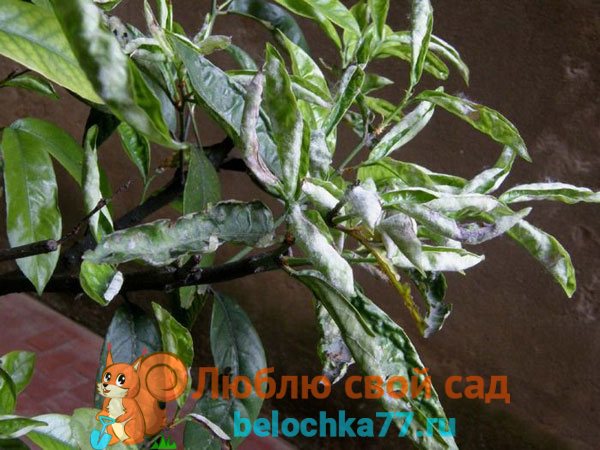

Anthracnose
The manifestation of the disease is rust-like spots that form along the edges of the leaves. Then holes appear in place of the spots. Ficus sheds diseased leaves and, as a result, can be completely bare. The disease is also treated with fungicides.
Gray rot
Caused by mold, the spores of which fly through the air when the leaf is shaken. As the lesion develops, brown spots appear on the leaves, which grow rapidly. The leaf plate darkens completely and the leaves fall off. Often the disease occurs in a stuffy and humid room that is not ventilated. All affected leaves must be removed and the plant treated with antifungal drugs. Watering for the duration of treatment is minimized.
How to propagate ficus at home
Cercosporosis
Often, the disease starts with excessive humidity in the room. It is caused by the special fungi Cercospora. The first symptoms can be seen on the underside of the leaves as small brown or black dots, which then increase in size. The leaves begin to turn yellow and fall off, in advanced cases, the death of the ficus is likely. It is treated by means of fungus.
Sooty mushroom
More often, the disease develops simultaneously with the attack of pests, since the fungus feeds on their secretions. Symptoms are the appearance on the leaf plates of a black bloom, similar to soot. It is difficult not to notice this disease. It is treated with special drugs.
Root rot
It is provoked by excessive watering. The disease can not always be noticed on time, since it occurs in the ground. The root system stops working normally, which causes the death of the plant. It is destroyed, the pot is also thrown away.


Ficus Benjamin's leaves turn yellow and fall, what should I do?
Insect pests
A weak plant is most often attacked. The rapid growth in the number of colonies provokes a strong closeness of flower pots and poor care of ficuses. By themselves, they do not lead to the death of the plant, but if infection with a fungus joins their negative activity, the flower can quickly die. To know the enemy by sight, you should familiarize yourself with the most common insects that are most likely to visit the plant, and more than once.
Spider mite
Prefers to be placed on the underside of the leaf and the tips of the shoots. Its bites result in gray-brown spots and dots on the outside of the foliage. Traces of cobwebs can be found on the ficus tree. Treatment: Washing with soapy water and further processing with Bordeaux liquid. You can spray the flowers with ground gray and garlic tincture, covering the ficus with plastic for 3-4 days. It helps well in the fight against pests and an insecticidal preparation.
Mealybug
Likes to settle in the axils of the leaves of old plants. The infected leaf is covered with a white bloom in the form of pieces of cotton wool, inside which insects live.


The appearance of a mealybug in the photo
Treatment: The parasite is washed off with soapy water, removed with a cloth soaked in alcohol, sprayed with tobacco solution once every three weeks. If there are a lot of bugs, the plant is treated with Confidor 2 times every 10 days.


Mechanical removal of mealybug in the photo
Likes to settle in piles on the underside of the leaf, sucking its juice. The affected areas turn yellow, the leaves curl and fall off. Treatment: Shower with soapy water or diluted pyrethrum.
Shield and false shield
In case of damage with a scab, on the inner side of the leaves along the veins, convex brown dots are noticeable. Soon the foliage turns yellow and falls off. Treatment: Complicated by the fact that the pests are covered with a shield that protects them from the action of chemicals. Insecticides affect only insect larvae. Adults are removed with a cotton swab dipped in a soap solution. Severely affected leaves are cut off. Healthy foliage and soil are sprinkled with tobacco dust. Ficus is processed with Aktilikom 3 times a day for 2-3 weeks.


Fox shield
Thrips
The larvae stick to the veins of the leaf from its inner side. Above, dark brown or yellow-white spots are characteristic. Inaction will lead to yellowing and death of foliage. Treatment: Complicated by the fact that adults live in the ground. For spraying, a solution of pyrethrum is used, such medicines as Aktar, Tanrek. The course of treatment is repeated several times.
Root nematodes
Nodules and growths 2-5 mm in size grow on the roots. The foliage turns pale and withers. Soon, the ficus dies. The difficulty lies in the fact that at the initial stage of nematode damage, there are no obvious signs of infection. Treatment: The roots are dipped in an insecticide solution for 2-3 hours, and then the ficus is transplanted into a new pot with replaced soil.
Pests
Most often, pests fall on a plant weakened by improper care. Their rapid reproduction provokes crowding of flower pots, non-compliance with sanitary conditions. Pests rarely cause direct death of the ficus, unless the grower has taken any control measures for a long time and the parasites have multiplied too much. Most often, the ficus dies if fungal diseases are added to the negative effects of pests. Whom can you find lurking on your favorite ficus?
Spider mite
Loves dry and warm air, multiplies quickly. After its bites, small gray or brown spots remain on the leaves. Such leaves begin to dry and fall off. It is urgent to increase the humidity of the air in any available way. You can use a humidifier or pallets of wet expanded clay. Leaves must be sprayed several times a day, wiped with a solution of simple soap. In case of severe infection, garlic infusion or industrial insecticides are used. The plant treated by them is covered with a bag for a more effective effect.


Mealybug
An insect that sucks sap from the foliage of a plant often hides in the leaf axils. Its appearance is noticeable by the deformations of the sheet plate and the termination of its growth. If symptoms have just appeared, mechanical cleaning and two-time treatment with soapy water or tobacco infusion will help. In advanced cases, they are treated with confidor. You will need to process the plant twice with an interval of 10 days.
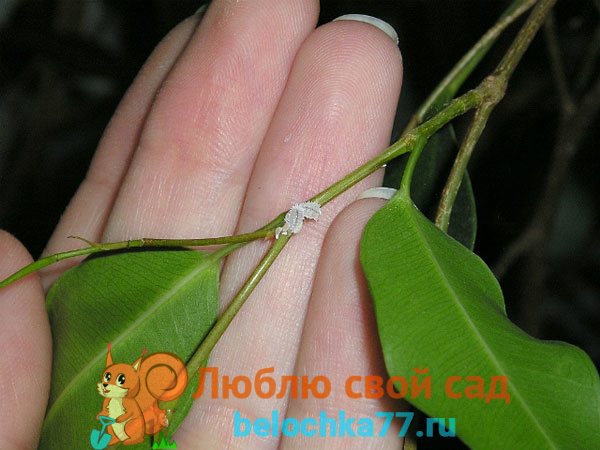

Aphid
A small parasite that feeds on the sap of the leaves of the plant. The leaves lose their shape, turn yellow and fall off. On the sticky traces of the pest's vital activity, fungi begin to parasitize, which leads to the death of the flower. As control measures, traditional treatment with soapy water or insecticides is used.
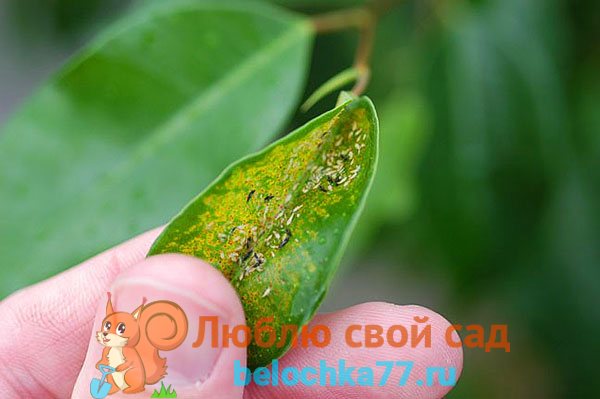

Shield
When attacked, you can notice the appearance of convex brown spots on the leaves. Sometimes these symptoms are also noticeable on the shoots. When processing the sap of the plant, the scabbard leaves sticky spots on it, which causes subsequent fungal damage. A thorough two-sided treatment of leaves with soapy water and Actellik helps against this pest. The treatment lasts 3-4 weeks, the treatment is carried out with an interval of 7 days.


Thrips
They spread quickly indoors, flying from one plant to another. You can see them curling near the windowsill.They often hide on the underside of leaves. They suck the juices from the plant, leaving brown spots on the leaves. These small black insects are very fond of high temperatures and excessive humidity. With a large lesion on the ficus, leaf fall begins. You can destroy pests with Aktara and other insecticides. Processing is carried out many times until the insects are completely eliminated.
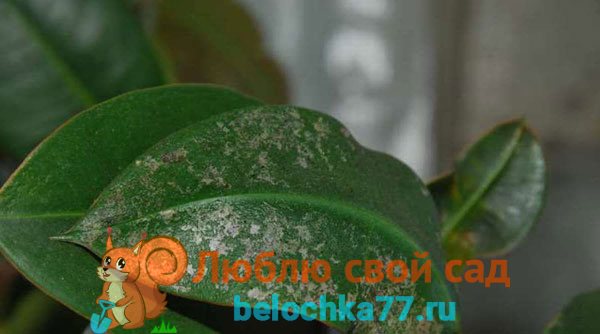

Root nematodes
When infected, the foliage of the ficus becomes faded. If there are suspicions of the appearance of nematodes, the plant is taken out of the pot and the root system is examined. The pest can be identified by the appearance of white rounded growths on the roots. Discharge of nematodes is toxic to the flower and can cause its death. When symptoms appear, the roots are soaked for several hours in an insecticide solution, after which the ficus is transplanted into fresh soil.
Ficus Benjamin - signs and superstitions
Prevention of ficus diseases
The new seedling is isolated for at least 7 days in a separate room. If, after quarantine, no signs of disease are found, then it is placed with the rest of the plants. To prevent the development of diseases, it is recommended to inspect the ficus daily for uncharacteristic external changes. It is undesirable to put pots close to each other. After transferring or transplanting flowers from the garden to the house, their leaves should be wiped with a solution of laundry soap.
Attention! Do not buy ficuses with damaged and sluggish leaves. A diseased plant will not be able to adapt to a new place and will quickly die.
Experienced growers advise you to regularly clean the trays and pots, do not overflow or overfeed the plant, monitor the level of humidity and air temperature in the room, and also do not put flowers under the scorching sun. Disinfection of self-prepared or store-bought soil is carried out using a weak solution of potassium permanganate. Treatment of ficus with a solution of fungicide, copper oxychloride and cuprozan will relieve the fungus. Any insecticide will work against insects.
To increase the resistance of ficus to external harmful factors, Epin and Zircon are used. In severe cases, it is necessary to replace the earth and transplant into a new pot with pruning of the affected areas of the stem and rhizome. Sections are powdered with charcoal powder. From March to September, once every two weeks, the soil can be fertilized with magnesium sulfate, Potassium Magom, iron chelate, Ferovite, dolomite or fertilized with Emerald leaf fertilizer.
Falling and yellowing of foliage
Why do ficus leaves turn black?
This may be due to the following factors:
- improper watering: too abundant or insufficient. Rubbery ficus reacts sharply to excess or lack of moisture, so try to revise the watering rates;
- lack of light. If the pot is in a dark place, try moving it to a brighter place, but not in direct sunlight. The tree should resume foliage growth. But the option of a new reset of foliage is possible due to the stress of rearranging to a new place;
- unsuitable pot. Too small or, conversely, a large pot can also cause yellowing. This problem is solved by the selection of a suitable capacity;
- diseases of the root system. Such diseases are determined by the smell from an earthen coma. If this smell is unpleasant, then the roots have begun to rot or are affected by disease.
Carefully remove all excess soil, rotting roots, dry them slightly and transplant them into a new pot.




